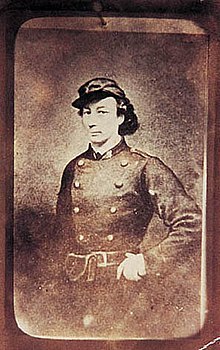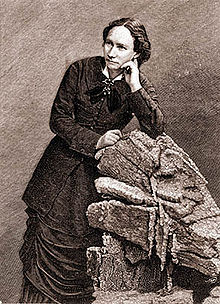Louise Michel
Following her penal transportation to New Caledonia she began to embrace anarchism, and upon her return to France she emerged as an important French anarchist, and went on speaking tours across Europe.
Among the members of the group were Michel,[5] Paule Minck, Eliska Vincent, Élie Reclus and his wife Noémie, Mme Jules Simon, Caroline de Barrau and Maria Deraismes.
The July 1869 manifesto of the Revendication des Droits de la Femme was thus signed by the wives of militant cooperative members.
However, Ferré and Rigault persuaded her to not carry out her plan to assassinate Adolphe Thiers, the chief executive of the French national government.
Michel fought with the 61st Battalion of Montmartre and organized ambulance stations during the beginning of the Bloody Week (May 21–28, 1871), the battle that ended the Commune [7] In her memoirs she later wrote "oh, I'm a savage all right, I like the smell of gunpowder, grapeshot flying through the air, but above all, I'm devoted to the Revolution.
[9] Michel ideologically justified a militant revolution, proclaiming: "I descended the Butte, my rifle under my coat, shouting: Treason!
On the attitude of her male comrades, she wrote, "How many times, during the Commune, did I go, with a national guardsman or a soldier, to some place where they hardly expected to have to contend with a woman?"
[18] In France she successfully campaigned, together with Charles Malato and Victor Henri Rochefort, for an amnesty to be also granted to Algerian deportees in New Caledonia.
[22] The teachings were influenced by the libertarian educationist Paul Robin and put into practice Mikhail Bakunin's educational principles, emphasising scientific and rational methods.
Once a teacher with progressive ideals, her activism saw her embrace revolutionary socialism, but the experience of a failed revolution turned her into a radical anarchist.
Her political theory progressed from peaceful reform to violent revolution, because she came to believe that contemporary society had to be completely destroyed for a new egalitarian era to emerge.
The ruling elites of the post-revolutionary monarchies believed that for the economy to succeed, it was necessary to control the labour market, wages and working conditions.
Michel's political characters fought for justice, while the children and animals in her fictional works were too weak, sick and starved to resist or survive.
When the Paris Commune was proclaimed Michel was named head of the Women's Vigilance Committee and played a key role in initiating economic and social reforms.
When Michel was tried, she demanded to be killed by firing squad and proclaimed "If you let me live, I shall never stop crying for vengeance, and I shall avenge my brothers by denouncing the murderers".
I thought about the behaviour of our friends of the Commune: they were scrupulous, so afraid of exceeding their authority, that they never threw their full energies into anything but the loss of their own lives.
"[36]Michel was introduced to the tenets of anarchism by a fellow prisoner Nathalie Lemel, with whom she was imprisoned in a large cage for several months.
[39] Eventually an amnesty was granted and when Michel returned to Paris in November 1880 she was greeted by Henri Rochefort, Clemenceau, a crowd of 20,000 and the police.
[41] As a public speaker Michel became skilled in advancing pragmatic arguments to attack capitalism and the authoritarian state, while holding open the possibility of a positive outcome.
In England, the meeting would have taken place; in France, they have not even made a legal admonition in order to let the crowd retreat, which would have left without resistance.
The revolutionary characters in The Strike expected to die, but instead they gave life to a new age and Michel discussed the rights and responsibilities of the people who lived in the aftermath of a revolution.
Michel's political ideals owed much to the French romanticism of Hugo and are described at length in The New Era, Last Thought, Memories of Caledonia (1887):[34] "It is indeed time that this old world die since no one is safe any longer... We can no longer live like our Stone Age ancestors, nor as in the past century, since the series of inventions, since the discoveries of science have brought the certainty that all production will increase a hundredfold when these innovations will be used for the general good, instead of letting just a handful of vultures help themselves in order to starve the rest.
She lamented the deficiencies of the capitalist banking system and predicted that the concentration of capital would result in the ruin of small enterprises and the middle class.
[48] The Manifesto had been signed by Peter Kropotkin, Émile Gautier, Joseph Bernard, Pierre Martin [fr] and Toussaint Bordat.
[52] Shortly before her death, when returning from her exile in London, Michel had been dubbed "the angel of petrol", "the virago of the rabble" and "queen of the scum" by the conservative French press.
The image of Michel as vierge rouge (red virgin) came to be used by conservative and liberal historians alike when recounting the story of the Paris Commune.
Despite the anti-authoritarian rhetoric, early anarchist thinkers maintained cultural orthodoxy when it came to the division of domestic labour and their personal relationships with women.
Michel, Teresa Claramunt, Lucy Parsons, Voltairine de Cleyre and Emma Goldman became prominent figures in the late 19th century pan-European and American anarchist movement.
[56] A movie by the French filmmaker Sarah Maldoror, The Commune, Louise Michel and Us (1971), now lost, was commissioned by the city of Saint-Denis.
Michel was one of 10 French women honoured during the 2024 Summer Olympics opening ceremony in Paris, where a gold statue of her was raised along the Seine river.






